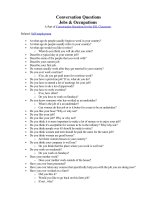Laboratory questions
Bạn đang xem bản rút gọn của tài liệu. Xem và tải ngay bản đầy đủ của tài liệu tại đây (70.42 KB, 4 trang )
Laboratory Questions (Page 298 - Calorimetry)
1. Part A.1. The 200mm test tube also contained some water (besides the
metal) that…
Answer: The temperature change will be lower. Water has higher specific
heat. It means that it can absorb higher amounts of heat and rise very litte in
temperature. Hence, the heat which was initially present is being absorbed
by water which doesn’t give required rise in temperature owing to it’s higher
specific heat
2. Part A.4
3. Part B.
Answer: Yes, in the case of all strong acid-strong base condition, all will
give same amount of enthalpy of neutralization. Where as in case of any the
acid/base or weak acid – weak base case, some amount of energy is used up
for the dissoaciation of weak acid/weak base then automatically enthalpy of
neutralization is less compared to that of strong acid – strong base condition.
Enthalpy of neutralization is the heat change when one equivalent of an acid
reacts with equivalent of base. One equivalent of an acid produces one mole
of H+ and one equivalent of base produces one mole of OH- ion. Thus in
another words heat of neutralization is the heat change when one mole H+
and one mole of OH- ion respectively. Hence heat of neutralization for all
strong acid-base reactions is same.
4. Part B.
Answer: q = mc∆ T
Where q = heat loss (in J) ; m = mass of substance ; c = specific capacity of
substance
q = 2.35 x 1.34 J/g.℃ x 6.22℃
q = 19.6 J
Heat loss to the inner 2.35g, Styrofoam cup is 19.6 J .
5. Part B.3
Answer: 40 ml will neutralize 44 ml of NaOH using N1V1 = N2V2 or say it
will neutralize 0.88 ml NaOH, unreacted 6 ml or 0.12M NaOH
6. Part B.3.
Answer: This factory error cause the reported energy of neutralization,
(delta) Hn will be unaffected because since the volume is kept constant and
when the concentration of the acid increases, the acid particles also increase.
So the concentration will be directly proportional to the temperature change.
Because neutralization is an exothermic reaction, during the reaction, the
temperature will increase until the point of neutralization (at which point the
temperature is at its highest), and after this point, the temperature will start
to decrease, so effect of temperature nullified.
7. Part C.3
Answer: If some salt remains in the paper, this means that you will not
include that specific mass of salt. Therefore, the heat measured will not be
the heat of the total mass but the heat of a smaller mass. The enthalpy will
be lower than that calculated or expected.
8. Part C.
Answer:
. Since it is not perfect, enthalpy would be lower since same of the heat will
be lost from calorimeter.
. NH4NO3 + Heat ------- NH4+ + NO3It is endothermic reaction. In endothermic reaction heat energy is absorbs.
So more amount of heat energy absorb the calorimeter, higher ∆ H would be
higher than one.
Laboratory Questions (Page 174 – Molar Mass of a Volatile Liquid)
1. Part A.1
a. It would be too high because the waters weight would be mistaken for
the mass of the vapor
b. If the mass of the water vapor is reported as too high, then the
reported molar mass will be too high.
2. Part A.1
Answer:
Too high because the oil from the fingers will increase the amount of mass overall
on the flask, and during calculations it'll seem like theres a greater mass of vapor
than there actually is
3. Part B.2
Answer: The reported molar mass of the liquid will be unaffected
because the vapor will remain inside the flask just in a different state. The
weight will not be negatively affected by this and the molar mass will be
unaffected as well
4. Part B.2
Answer:
Too high because when calculating moles of vapor using PV=nRT if the
temperature is too high then the calculated moles will be too low. Then when you
divide the mass by these too low moles then the molar mass will be too high
5. Part C.1
Answer: The calculated molar mass would be too low. Because of this
assumption, there would be a decrease in the volume. So, as the volume
decreases, the moles calculated would also be too low due to the direct
relationship between volume and moles.
6. Part C.2
Answer: Too low because when calculating moles of vapor using PV=nRT
if the pressure if too high then the calculated moles will be too high. Then
when you divide the mass by these too high moles then the molar mass will
be too low









